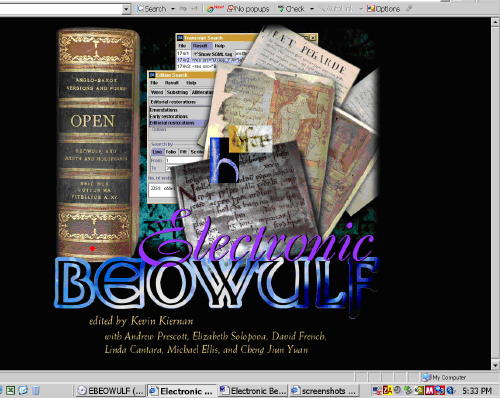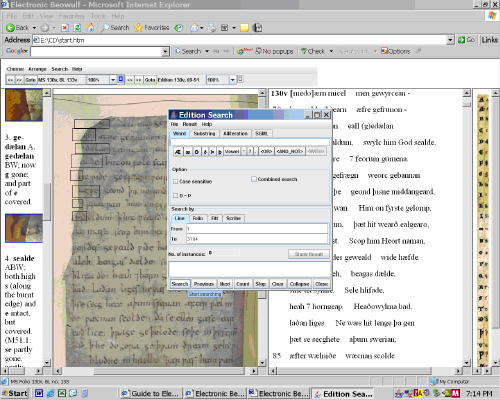Related Categories:New Approaches to Reading Print Texts
Summary: “Electronic Beowulf Project” is an image-based CD-ROM edition of Beowulf, the great Old English poem, which survives in only one manuscript: British Library Cotton Vitellius A. xv. The CD is a full-color digital facsimile of Beowulf, its associated texts, and glossaries. Future editions will include illuminations from contemporary manuscripts and external links to medieval and Anglo-Saxon resource sites.
Description:
The Beowulf manuscript was badly burned in a 1731 fire and restored during the 19th century. Despite its restoration and an available black and white facsimile, many aspects of its text and textuality have been unavailable to readers.

Image from Electronic Beowulf
In 1993, as part of a British Library initiative, Anglo-Saxonists Kevin Kiernan (Univ of Kentucky) and Paul Szarmach (Univ of Western Michigan) began the “Electronic Beowulf Project.” Its purpose is to create a digital archive of Cotton Vitellius and associated manuscripts, then produce a full-color electronic facsimile of the Beowulf texts. All pages of the manuscripts were captured on a high-resolution digital camera, using bright daylight and ultra-violet lighting. These images have revealed hidden letters, palimpsests, and information about the manuscript’s textual production.
In addition to digital images of the Beowulf manuscript, “Electronic Beowulf” includes images of indispensable eighteenth-century transcriptions, copies of the 1815 first edition with early nineteenth-century collations of the manuscript, a comprehensive glossarial index, and a new edition and transcript, both with search facilities. On each manuscript page there are hotspots that give the reader a closer look at parts of the manuscript. Once one clicks on a hotspot, a toolbar appears along the left-hand column of the screen that contains an enlarged picture of the small section of the manuscript, followed by a description of what has happened to that section. A Search feature allows the reader to search all instances of a word in the Beowulf manuscripts.
Future editions will include images of contemporary illuminations, links to the Toronto Dictionary of Old English project, and comprehensive Anglo-Saxon bibliographies of the Old English Newsletter.
The technological requirements of this project have engendered theoretical interest among computer scientists, statisticians, mathematicians, and library scientists at the University of Kentucky. This group of scholars formed GRENDL (Group for Research in Electronic ally Networked Digital Libraries) and developed software that links all files in the CD by hyperlink. As the “Electronic Beowulf” website notes, “A reader studying a given folio of Beowulf can now superimpose enhanced, back-lit, or ultraviolet images over covered or erased readings; bring in for comparison the corresponding pages from a transcript, a collation, an edition, a translation, or other popular portrayals; access an Old English glossary or a related archaeological find; or initiate a bibliographical search and retrieval of a related article.”
 Interface of Electronic Beowulf
Interface of Electronic Beowulf
Research Context:
The cultural, technological, and scientific aspects of this project touch on Medieval Studies, Computer Science, Library Science, Mathematics, and Statistics. More broadly put, this project brings together the humanities and the sciences, medieval studies and modern technology. Consequently, this project is relevant to History of the Book, New Media Studies, and reading technologies.
Technical Analysis:
In 1993, all pages of the manuscripts were captured using a Roche/Kontron ProgRes 3012 digital camera, which scans at 2000×3000 pixels in 24-bit color. Each page was photographed in both ultra-violet lighting and in bright daylight. After all the pages were warehoused in a database, GRENDL developed software that would link all aspects–material and research–of the project together, and in 1999, the Beowulf CD was published. In 2003, online updates for the CD were made available. This report was compiled by using the 1999 CD in conjunction with 2003 updates.
Evaluation of Opportunities/Limitations for the Transliteracies Topic:
“The Electronic Beowulf Project” is the first large-scale digital facsimile project of its kind. It has redefined 1) our access to fragile manuscripts and 2) the reading practices of these manuscripts. Archival access to medieval manuscripts has traditionally been considered to be the most intimate and accurate way to ‘know’ a text. This project changes that notion and, in turn, the future history of manuscript reading. It is an example of the transition that is being made between traditional libraries and digital libraries.
Transliteracies can use “Electronic Beowulf” as a model for multi-dimensional reading. It employs defining aspects of online reading (i.e. internal and external links) as technologies for generating a network of information by way of one text. Likewise, the capability of layering different shots of the same image can help us further our thinking about reading as a synchronic activity. It can also contribute to our (re)definition of manuscript textuality; such textuality includes not just the print on a page but also the changes that have been made to that page: erasures, palimpsests, damage, etc.
Resources for Further Study:
- Kiernan, Kevin. “Electronic Beowulf.” Retrieved 19 February 2006.
A number of medievalists and scientists have published articles about the manuscript restoration processes and technological applications of Beowulf and Electronic Beowulf Project. These articles are all linked to Kiernan’s website.
- “Constructing a Glossary for The Electronic Beowulf“
- “The Conybeare-Madden Collation of Thorkelin’s Beowulf“
- “Digital Image Processing and the Beowulf Manuscript”
- “The Electronic Beowulf and Digital Restoration”
- ”’Their Present Miserable State of Cremation’: the Restoration of the Cotton Library”
- “Encoding a Transcript of the Beowulf Manuscript in SGML”
Point(s) for Expansion:
“Electronic Beowulf” is the first in a growing number of digital facsimile projects. Others include:
- A digital facsimile of Oxford, Bodleian Library, MS. Junius 11, Oxford : Bodleian Library, University of Oxford, 2004.
- The Exeter Anthology of Old English Poetry CD facsimile, to be released by University of Exeter Press, March 2006.
- Les Tres Riches Heures du duc de Berry, CD, Réunion des musées nationaux, 2004 Bayeux Tapestry Electronic Resource, Leicester, UK : Scholarly Digital Editions, 2003.
- The electronic texts and concordances of the prose works of Alfonso X, El Sabio, Madison, WI. Hispanic Seminary of Medieval Studies, 1997.
A number of research libraries that house aging manuscripts have begun to digitize all or portions of their collections:
- The Bodleian Library’s digital facsimiles include not only medieval manuscripts, printed ephemera, and 18th-19th century journals, but also an image catalog.
- Berkeley’s Digital Scriptorium is a database of medieval and renaissance manuscript images from many institutions. These institutions include Berkeley, Colombia University, University of Texas, Austin, New York Public Library, Houghton Library (Harvard University), and Walsh Library (Fordham University).
- The Parker Library, Corpus Christi College Cambridge has established a prototype website called Parker on the Web that currently offers a limited selection of web images from the CCCC manuscript collections.
